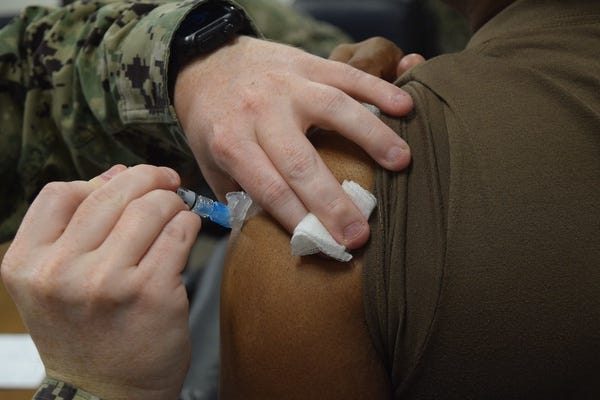Way(back): Cyreena Boston Ashby on COVID-19
A year ago, the vaccine brought hope. That hope did result in some progress. Now, a year later, we must double down on proven solutions.
What is a “Way(back)”? These pieces are short reflections from contributors on previous Oregon Way pieces that left an impact on them.
A year ago, I wrote about the newly arrived COVID-19 vaccine that had just landed here in Oregon. Expressing concerns about our state’s contemporary history of vaccine hesitancy, along with the ever-present issue of racism in the American medical system, I warned that Black and Hispanic people as demographics most effected (still are) by COVID-19 could be likely to decline to vaccinate as well. I cautioned that a slow take to the vaccine would only hamper our fight against the pandemic.
What’s happened since?
As of mid-December, 58% percent of White people received at least their first COVID-19 vaccine dose, which was close to the rate for Hispanic people (56%) but higher than the rate for Blacks (51%), according to the Kaiser Family Foundation. In Oregon, the vaccination rate among the White population is ten percentage points above their national average. Black and Hispanic Oregonians are comparable to their national counterparts.
These disparities have become even more problematic now that the FDA includes vaccine-eligible children in their calculations. Still, some hope still exists that racial differences in vaccine adoption will decrease among young Oregonians and Americans. Currently, the youngest vaccine-eligible population has barely reached double digit percentages on receiving their first dose.
The plethora of data to guide our public health policy has only confirmed our initial hypothesis rather than directed a substantial effort to reduce disparities. A year ago, a lack of data justified some of the slow reactions of policy makers to assisting communities most likely to express vaccine hesitancy. Now, there’s no such excuse.
We have the necessary tool to protect members of these communities. Here we are today, not only with the vaccine available for all, but also booster shots readily available to all those over the age of twelve who are fully vaccinated. A year later, we must do a better job of improving vaccination rates for all.
COVID-19 is still here, with all of its variants. Right after the Delta variant loomed over us, along came Omicron, which has complicated our winter and holiday season. Breakthrough cases are rapidly unfolding all over the country, and as I write this, the daily case rate has broken a record—doubling the original highest record of daily COVID-19 cases. COVID-19 is not going anywhere.
But we must not give up. Surely, we have made progress. With vaccination rates increasing, COVID-19 deaths have decreased in Oregon. Yes, that’s some genuine good news. And despite the pandemic’s ongoing evolution, breakthrough cases are extremely low in Oregon—just .08%.
The coming year cannot repeat the mistakes of 2021. This must be the year of investing not only in the solutions having the greatest effect on fighting COVID-19 but also investing more in public health at large.
In order to keep fighting COVID-19 we must continue to invest in public health. The public’s health. Our ability to limit the spread of Omicron or any forthcoming variants is contingent upon continuous education with communities and all Oregonians. That education must include accessible materials and trusted teachers.
We must, at the very least, fund statewide, language translated public health campaigns about COVID-19 vaccine availability, vaccine boosters, symptom screening, and reporting. Led by the correct surrogates entrusted within Oregon’s BIPOC communities, these educational efforts could apply to COVID-19 and other healthy behaviors.
Once we have this educational network set up, we should not stop this, ever. Whereas trust in government may always be a challenge to mitigate, the general public now relies on public health in way that they may not have imagined, and instead of allowing that trust to diminish, we must use this as a time to explore new ways to address public health while also slowing building back the rapport between the public and the government.
Lastly, I support and urge Oregon to never end its pandemic coordination between state and local public health, hospital systems, insurers, medical and traditional health workers, and community-based organizations. Sharing data, sharing solutions, and sharing resources must be a new normal.
Last evening, I was speaking with my mother who recalled every pre-vaccine disease or outbreak she survived, including tuberculosis. Every disease she listed off now has a vaccine offered to all infants, children, and adults today, including under the Oregon Health Plan. I cannot help but to wonder and hope that not just next year but for decades ahead, I will be able to reflect on how simple and basic this essential vaccine process will become and how much public health and its coordination has modernized.
This post is not a bad progress report, but a reminder that we have the tools to combat the spread of COVID-19. We just need a larger network to spread those solutions. Ideally, if I have to report back in twelve months, it will be another “keep up the great work” report.
Happy New Year!
Cyreena is CEO at Girls Inc. of the Pacific Northwest, and of Counsel at Hilltop Public Solutions. She has worked on Oregon’s pressing issues of economic development, public health and health care, housing, and racial equity.
Related pieces:
Photo credit: "201001-N-HU933-111" by NavyMedicine is licensed under CC PDM 1.0





